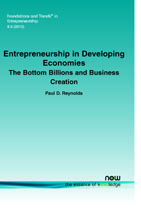Entrepreneurship in Developing Economies: The Bottom Billions and Business Creation
By Paul D. Reynolds, Research Professor of Management, School of Business, George Washington University, USA, pauldavidsonreynolds@gmail.com
Abstract
Over 100 million of the 1.8 billion midlife adults living on less than $15 a day are attempting to create new firms. Another 110 million are managing new ventures. This is almost half of the global total of 450 million individuals involved with 350 million start-ups and new ventures. They are responsible for almost half of all new firms and onethird of new firm jobs. For the poor, business creation provides more social and personal benefits than illegal and dangerous migration, criminal endeavors, or terrorism. Almost all of the business creation by the bottom billions occurs in developing countries, half are in Asia. The ventures initiated by the bottom billion are a significant proportion of all firms expecting growth, exports, an impact on their markets, and in high tech sectors. Assessments based on multi-level modeling suggest that young adults, whether they are rich or poor, in countries with access to informal financing and an emphasis on traditional, rather than secular-rational, and self-expressive values are more likely to identify business opportunities and feel confident about their capacity to implement a new firm. Such entrepreneurial readiness is, in turn, associated with more business creation. Compared to the strong associations of informal institutions with business creation, formal institutions have very modest and idiosyncratic relationships. Expansion of access to secondary education and early stage financing may be the most effective routes to more firm creation among the bottom billion.
Entrepreneurship in Developing Economies
Entrepreneurship in Developing Economies: The Bottom Billions and Business Creation examines the extent to which "the poor" are already involved in business creation and the nature of the ventures they pursue to understanding how to assist developing nations grow their economies. The assessment uses a unique data source from the Global Entrepreneurship Monitor [GEM] program that has only recently become available. The assessment has five components. 1. Review the procedure used to identify the "bottom billions" including their global distribution and personal characteristics. 2. Review the relationship of different levels of daily income with participation in two initial stages of the firm life cycle – nascent entrepreneurs in the pre-profit or start-up stage and owner-managers of new firms. 3. Examine the personal characteristics of those active in business creation and the effect of personal characteristics on the tendency to become involved in business. 4. Review the major features of these ventures and firms–type of the business activity, orientation toward job creation, operating in high technology sectors, expecting a market impact, and export sales. 5. Identify the national features and individual characteristics systematically associated with participation in business creation. Entrepreneurship in Developing Economies: The Bottom Billions and Business Creation concludes by providing an overview of the major patterns and explores selected policy implications.
